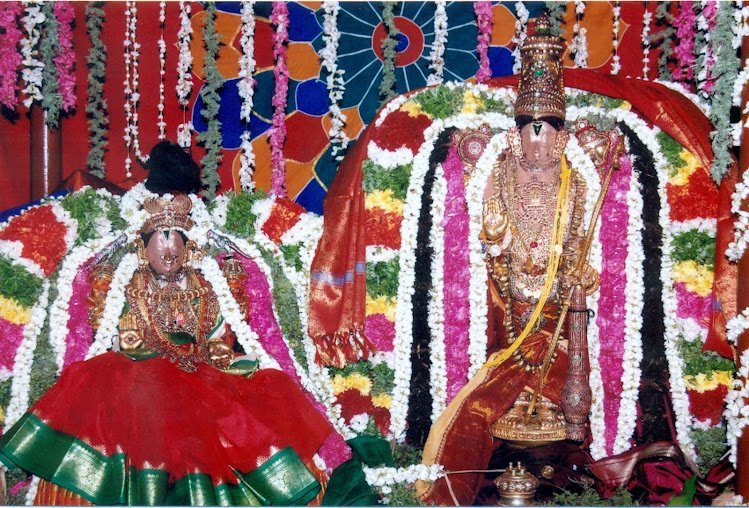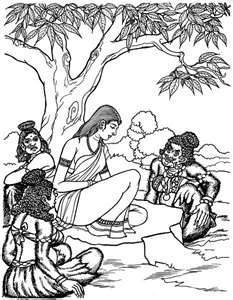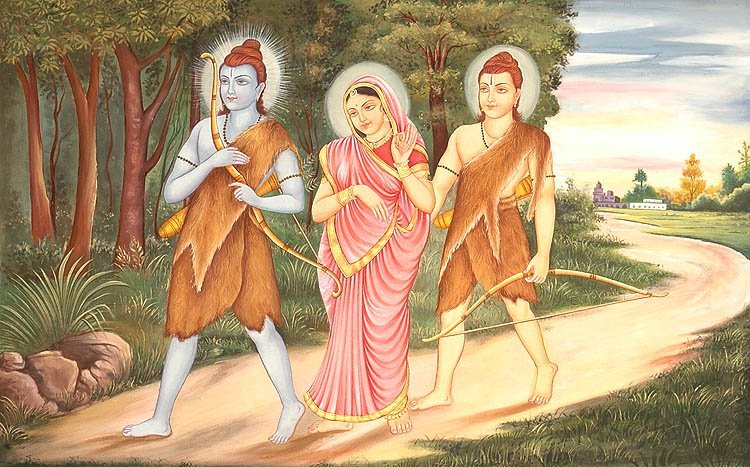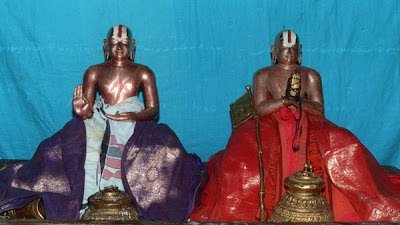srI:
srImathE rAmAnujAya nama:
srImadh varavaramunayE nama:
srI vAnAchala mahAmunayE nama:
emperumAnAr explains to vangi puratthu nambi the obstacles that are faced by srIvaishNavas in various aspects of day-to-day life. vangi puratthu nambi
documents these instructions in a wonderful grantham with commentary
named virOdhi parihArangaL (removal of obstacles). We are now viewing
the English translation of this grantham with the help of the
explanations given by srI U. vE. V V Ramanujam swamy. The whole series
can be viewed at https://granthams.koyil.org/virodhi-pariharangal-english/.
Please see the previous article at https://granthams.koyil.org/2013/12/virodhi-pariharangal-5/.
30. vishaya virOdhi (விஷய விரோதி) – Obstacles for bhagavath vishayam

irresistible nectar – ArAvamuthan – most enjoyable
vishayam generally means bhagavath vishayam (matters relating to bhagavAn). Anything contrary to that is an obstacle.
- Matters such as sabdha (sound), sparsa (touch), rUpa (vision), rasa (taste), gantha (smell), etc., which give material pleasures to our senses are a hurdle for bhahgavath vishayam. Translator’s note: When one engages in sensual pleasures it increases the rajO and thamO guNam in oneself and naturally moves the person away from bhagavAn. AzhwArs have themselves cried out in many pAsurams that these wordly pleasuers are very powerful and they torment them constantly.
- Listening the names of bhagavAn is naturally good for the jIvAthmA. bhagavAn himself considers these as sukrutham (good acts) done by jIvAthmAs when they listen/utter the names of bhagavAn (even unintentionally). Not listening to bhagavAn‘s names or listening to other’s names are obstacles.
- bhagavAn‘s archA vigrahams (and pictures/drawings of the same) are most enchanting. Looking at material bodies is an obstacle.
- Reciting others names instead of reciting bhagvAn’s names is an obstacle.
- The legs given to us are to be used to go to bhagavAn‘s kshEthrams (dhivya dhEsams, etc). Using them in going to other dhEvathAs kshEthrams is an obstacle.
- nammAzhwAr speaks about the glories of bhAgavathas in thiruvAimozhi 2.7 “payilum chudaroLi” (பயிலும் சுடரொளி) padhigam and 8.10 “nedumARkadimai” (நெடுமாற்கடிமை) padhigam. With this understanding, one should know that glorifying bhAgavathas is greater than glorifying bhagavAn. So, just worshipping bhagavAn‘s archA vigraham without serving bhAgavathas is an obstacle.
- Reciting bhagavAn‘s names instead of reciting bhAgavathas names is an obstacle. For example, it is explained by our pUrvAchAryas that the name “rAmAnuja” is greater than “nArAyaNa” and reciting emperumAnAr‘s names is most desired. vaduga nambi once hears some one reciting “nArAyaNa” and says “One must recite ‘rAmAnuja’ only, simply saying ‘nArAyaNa’ is ‘nAva kAriyam’ (inappropriate act)” and walks away from that spot.
- Touching (the lotus feet of) bhAgavathas is good for oneself. But touching samsAris or being touched by them is a major obstacle. Translator’s note: In parAsara bhattar‘s life, an incident is highlighted in this connection. While walking in the streets of srIrangam, a devotee of some other dhEvathA wearing colored dhOti comes close to bhattar and makes bhattar think that he may touched him. bhattar at once becomes very disturbed and goes to his mother ANdAL ammA and asks her for a remedy. She instructs bhattar to accept the srIpAdha thIrtham from a bhAgavatha who is not upavIdhI (one who does not wear yagyOpavIdham). bhattar somehow convinces one bhAgavatha who performs srIpAdham kainkaryam to namperumAL to present their srIpAdha thIrtham and feels satisfied. If, bhattar who is namperumAL/nAchiyAr’s adopted son himself fears so much for the touch of samsAris, we can understand how careful we should be.
- thuLasi is very dear to emperumAn. But we should only smell the thuLasi leaves that are offered to bhagavAn. Smelling thuLasi that is not used in worshipping the lotus feet of bhagavAn is an obstacle. Translator’s note: Everything animate and inanimate is owned by bhagavAn and exist for the pleasure of bhagavAn only. They should be first offered to bhagavAn and then accepted as prasAdham – nothing can be independently enjoyed by us.
31. visvAsa virOdhi (விச்வாஸ விரோதி) – Obstacles for our faith in upAyam

sIthA pirAtti demonstrated full faith on srI rAmA in most adverse situation
visvAsam means firm faith. Here we are looking at firm faith in upAyam for mOksham. Our pUrvAchAryas have explained based on sAsthram that bhagavAn is the apt upAyam for mumukshus. Translator’s note: The same principles are explained by mAmunigaL in the vyAkyAnam for piLLai lOkAchAryar‘s mumukshuppadi sUthram 116 while explaining “pERu thappAthenRu thuNinthirukkaiyum” (பேறு தப்பாதென்று துணிந்திருக்கையும்) – one should be firmly faithful that the desired goal of eternal bhagavath kainkaryam will be achieved.
- prapatthi is the act of praying to emperumAn to be the upAyam. It is simply the state of mind accepting bhagavAn as the upAyam. It is a very simple step. Yet, this is all that is required from our part. One should not think that “oh! This is a very simple step. How will this simple act make bhagavAn become upAyam?”. Having such thoughts is an obstacle.
- upEyam is the result of pursuing upAyam. For srIvaishNavas, eternal kainkaryam in paramapadham (srIvaikuNtam) is the ultimate goal. And this kainkaryam in paramapadham is most wonderful and unimaginable to achieve by ones own self-efforts. nammAzhwAr says in thiruvAimozhi 5.1.7 “ammAn AzhippirAn avan evvidaththAn yAnAr” (அம்மான் ஆழிப்பிரான் அவன் எவ்விடத்தான் யானார் – My lord is the one who holds chakram in his hand – how great he is and how lowly I am) out of great joy that bhagavAn blessed him. So, one should not think of his greatness and we may not achieve kainkaryam to him because of our meekness – that is an obstacle.
- There are so many obstacles in samsAram. Fearing for those obstacles is an obstacle. Translator’s note: In mumukshuppadi charama slOka prakaraNam, while explaining “sarva pApEbhyO mOkshayishyAmi mA sucha:“, piLLai lOkAchAryar beautifully highlights bhagavAn‘s promise that all obstacles will be removed by him. mAmunigaL has expertly explained these principles in the vyAkyAnam.
- Not having faith in charamOpAyam (ultimate upAyam) is an obstacle. Both prapatthi and AchArya abhimAnam are explained as charamOpAyam. For prapatthi one should not consider that its a simple act and how will this simple act earn us eternal kainkaryam? For AchArya abhimAnam, one should not consider AchAryan is also a human like us, how will we help us get mOksham? Both are to be avoided. Translator’s note: piLLai lOkAchAryar explains in mumukshuppadi charama slOka prakaraNam that “sarva dharmAn parithyajya” gIthA slOkam is called charama slOkam because it explains the charama upAyam (saraNAgathi). There is a grantham written by nAyanArAchAn piLLai which explains the glories of emperumAnAr (as AchArya) and is named charamOpAya nirNayam.
32. pravruththi virOdhi (ப்ரவ்ருத்தி விரோதி) – Obstacles for our actions (kainkaryams)

iLaya perumAL (lakshmaNan) – the first one to be counted amongst shining servitors of bhagavAn
- We should understand that kainkaryam to emperumAn is the fitting action for our nature. kainkaryam is karthavyam – to be pursued naturally. Performing kainkaryam just as following vidhi (rules) is an obstacle.
- kainkaryam should be done with great love. nammAzhwAr says in thiruvAimozhi 10.8.10 “uganthu paNi cheythu” (உகந்து பணி செய்து – serving with love). Performing kainkaryam without such love is an obstacle. Translator’s note: We have already seen the true nature of kainkaryam in previous definitions – “bhagavath anubhava janitha prIthi kAritha kainkaryam” (பகவத் அநுபவ ஜநித ப்ரீதி காரித கைங்கர்யம்) – one experiences bhagavath guNam, etc., that leads to loving attachment and that leads to kainkaryam. If it was simply done without attachment it is against the svarUpam of jIvAthmA.
- Citing ones pArathanthriyam not being anxious during kainkaryam is an obstacle. One should think “this is emperumAn‘s kainkaryam; we should complete it properly; we should not be committing mistakes and so on” – such thoughts will naturally lead to anxiety. Even during our thiruvArAdhanam at the end, everyone recites “upachArApadhEsEna kruthAn – apachArAnimAm sarvAm kshamasva purushOththama” (உபசாராபதேசேந க்ருதாந் – அபசாராநிமாம் ஸர்வாம் க்ஷமஸ்வ புருஷோத்தம) – I started doing kainkaryam to you but ended up committing many mistakes in process, you being the best among purushas, kindly forgive me. Being casual without any anxiety is an obstacle. Translator’s note: When kaNNan emperumAn visited vidhura’s palace, vidhura was filled with anxiety that he offered the banana peels to emperumAn. Yet kaNNan emperumAn greatly appreciates vidhurAzhwAn’s loving service. This is why vidhurAzhwAn is called “mahAmathi” – one who is greatly knowledgable – for being anxious to serve emperumAn.
- Considering ones anushtAnam as sAdhanam (upAyam) is an obstacle. svAnushtAnam (ones anushtAnam) includes karmAs that are ordered by bhagavAn as essential. Not performing such acts will lead to accumulation of sins. But performing them will not add any pious karmA – they are mandatory. One should not consider such anushtAnams as upAyams that will force emperumAn to give us mOksham. vihitha karmA includes sandhyAvandhanam thrice a day, thiruvArAdhanam for home perumALs, pithru tharppaNam, etc.
33. nivruththi virOdhi (நிவ்ருத்தி விரோதி) – Obstacles for inaction (renunciation)

piLLai lOkAchAryar and mAmunigaL (srIperumbUthUr) – clearly explained the principle of renunciation in mumukshuppadi
nivruththi means renunciation/being detached. One who accepted emperumAn alone as upAyam will have to give up all other upAyams. bhagavAn says in gIthA charma slOkam that “sarvadharmAn parithyajya” (ஸர்வதர்மாந் பரித்யஜ்ய) first give up all upAyams and then “mAmEkam charaNam vraja” (மாமேகம் சரணம் வ்ரஜ) surrender unto me only. So, according to this, one should fully give up attachment to all other dharmams (upAyams such as karma, gyAna, bhakthi yOgams) and accept bhagavAn alone as the supreme dhramam. Translator’s note: Our AchAryas establish that srIman nArAyaNan alone is supreme dharmam as cited in mahAbhAratham “krishNam dharmam sanAthanam” (க்ருஷ்ணம் தர்மம் ஸநாதநம்) – kaNNan emperumAn is the eternal dharmam and srI rAmAyaNam “rAmO vigrahavAn dharma:” (ராமோ விக்ரஹவாந் தர்ம:) – srI rAma is embodiment of dharmam. piLLai lOkAchAryar majestically explains this in mumukshuppadi sUthram 213 “dharma samsthApanam paNNap piRanthavan thAnE ‘sarva dharmangaLaiyum vittu ennaippaRRu’ engaiyAlE sAkshAth dharmam thAnE engiRathu” (தர்ம ஸம்ஸ்தாபநம் பண்ணப் பிறந்தவன் தானே ‘ஸர்வ தர்மங்களையும் விட்டு என்னைப்பற்று’ என்கையாலே ஸாக்ஷாத் தர்மம் தானே என்கிறது) – bhagavAn appears as krishNan to establish dharmam – when he says ‘give up all other dharmams and accept me’ that means he is the real/eternal dharmam.
- Even after understanding all of these, if one considers “would I get some sin for giving up these other upAyams?” that is an obstacle. This only shows the lack of faith in bhagavAn. The objective will also not be fulfilled due to such doubting.
- Performing such actions with doubt in emperumAn is also an obstacle. Translator’s note: One should not think “what if my prapatthi fails? May be I should also do a little bit of karma, gyAna or bhakthi yOgam so that will back me up”. It is explained that bhagavAn is like brahmAsthram. When brahmAsthram is applied, it will easily arrest the opponent. But if one doubts the powers of brahmAsthram and try to tie down the opponent with any additional protection, the brahmAstharam will withdraw itself. This is what happened when hanuman was arrested by brahmAsthram and later when the rAkshasas tied him with ropes, brahmAshtram let hanuman free. hanuman eventually goes to rAvaNa’s court, warns him and sets lankA on fire subsequently.
- Giving up other upAyams simply due to ones own asakthi (incapability) is an obstacle. One should consider that other upAyams are not suitable for the svarUpam and thus give them up.
- Giving up other upAyams because one is capable to is an obstacle. Similar to above – they should be given up to fulfill the true nature – not for any other reason. Translator’s note: For example, one may be able to give up karma yOgam and thinking that “Oh! I am very much in control, so I am giving up karma yOgam” – this is not good either.
- One should also not boast about giving up attachment to all upAyams – that is an obstacle too. If one is able to do that, that is natural for jIvAthmA and happens by the grace of emperumAn and AchAryas – one should not praise oneself for doing that and think that “I have given them all up! how great?”.
One should constantly remember, piLLai lOkAchAryar‘s mumukshuppadi sUtram 271 – “karmam kainkaryaththilE pugum; gyAnam – svarUpa prakAsaththilE pugum; bhakthi prApya ruchiyilE pugum; prapaththi – svarUpa yAthAthmya gyAnaththilE pugum” (கர்மம் கைங்கர்யத்திலே புகும்; ஞானம் – ஸ்வரூப ப்ரகாசத்திலே புகும்; பக்தி ப்ராப்ய ருசியிலே புகும்; ப்ரபத்தி – ஸ்வரூப யாதாத்ம்ய ஞானத்திலே புகும்). mAmunigaL beautifully explains the necessity for performing all such activities out of compassion towards whole community (if great persons give up these vihitha karmAs, others will follow and simply fall down) – yet one should never consider them as upAyam – they are done as kainkaryam. Whatever karmA done (like sandhyAvandhanam, etc) – they will become part of kainkaryam towards emperumAn. Whatever acquired through gyAna yOgam will lead to the enlightenment of the soul. Whatever performed as part of bhakthi will help improve our loving attachment towards bhagavAn. And finally the prapatthi will fit into the intrinsic nature of jIvAthmA in accepting bhagavAn alone as upAyam.
We will continue with the next section in the next article.adiyen sarathy ramanuja dasan
archived in https://granthams.koyil.org, also visit https://granthams.koyil.org, https://acharyas.koyil.org, https://sriperumbuthur.blogspot.com
In telugu – https://granthams.koyil.org/2019/04/21/virodhi-pariharangal-6-telugu/
In hindi – https://granthams.koyil.org/2019/04/21/virodhi-pariharangal-6-telugu/
In kannada – https://granthams.koyil.org/2022/10/07/virodhi-pariharangal-6/